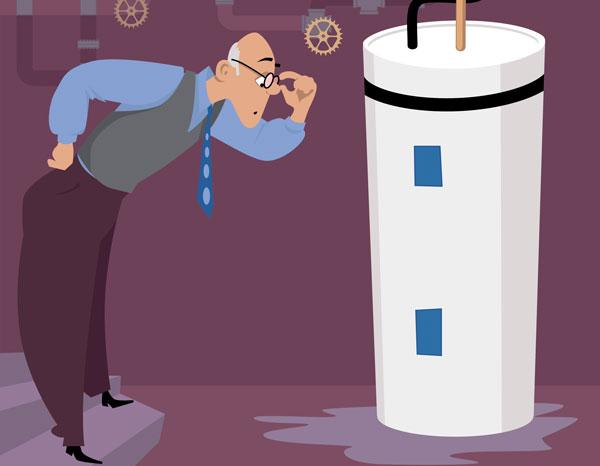Is your water heater just making noise or could it be leaking? The sounds of rushing water paired with rising water bills and visual water damage often point to water heater leaks. Learn how to check if your water heater is leaking to minimize damage and water waste.
Use Your Ears to Hear the Water Heater Leaking
If you’re concerned that you may have a water leak, turn off external sources of sound like the radio or television and let your senses be your guide. Many times you can hear a leak before any sign of water damage is apparent. If you hear water rushing or dripping while you stand beside your water heater, follow the sound and search for visual confirmation of a leak. If you can hear water, but no leak is apparent, there may be a break inside the tank. This can happen as a result of normal wear and tear and requires replacing the tank.
Use Your Eyes to Look for Signs of the Water Heater Leaking
The exact exit point of a water leak can be difficult to determine if the leak is slow, multiple leaks are present or water is pooling around a potential source. Sometimes a leak is hard to see because the unit is wrapped with an insulating blanket. Because of this, it’s helpful to know the most common places water heater leaks occur.
Look at the Top of the Heater
Check the top of the heater where water enters and leaves the tank. This is where a water heater is likely to fail because the tubes entering the tank are vulnerable to leaks due to high pressure.
- Inspect the tubes or pipes themselves and the entry points where they meet the tank and may have lost sufficient seal.
- Check the pressure relief valve near the top of the tank. Older valves occasionally leak and must be replaced after wear and tear.
Check the Bottom of the Heater
The drain valve, located at the bottom of the tank, is the likely source of water heater leaks.
- Check the drain valve for escaping water. In the case that a small drip is occurring, a garden hose cap or sprayer makes a quick leak fix until the valve can be replaced. Replacing the drain valve is relatively simple and fairly inexpensive.
- If you observe a pool of water forming beneath the tank, a leak inside the tank wall could be the culprit. Sediment buildup at the bottom of the tank can corrode the tank’s inner lining and cause failure. Combine that with the wear and tear of heating and cooling water and a new water heater is usually the solution.
Electric Water Heater Leaks Versus Gas Water Heater Leaks
If you still haven’t found a leak, but want to take a closer look, what you do next depends on whether your water heater is gas or electric.
Electric Water Heater
If you suspect your electric water heater is leaking, but are unsure of the source, turn off power to the heater. Remove the access panel and safety shield to check around the elements for signs of staining and water heater leaking.
If leaks are apparent, but the tank is relatively new, you may need to tighten nuts and bolts. If this does not work, element washers may need to be replaced.
Gas Water Heater
For gas heaters, if you see rust without signs of a leak, condensation may be forming inside the tank. Use your eyes and ears to check for water dripping onto the burner while it is in use.
Water dripping onto the burner between heating cycles could be a sign of tank failure. If you observe this happening, you can turn the gas off via a switch or dial on the side of the heater until you have the tank replaced. A puddle of water on the floor could also come from tank condensation.
Note: whether your water heater usages gas or electricity, make sure it is securely anchored to the wall. You do not want it to fall during an earthquake. Bracing kits are available at local hardware stores to help make this process quick and easy!
What to Do Once You’ve Found a Water Heater Leak
Once you’ve confirmed that your water heater is leaking, shut off the breaker that supplies power (if it’s an electric heater) or turn off the switch (or turn down the dial) that supplies the gas.
Next, shut off the water supply to the heater. If you’re not sure where it is, follow the pipe that enters the heater until you come across the valve, then close it. Remember – righty tighty, lefty loosey.
You can do small repairs, like tightening a loose connection or adjusting the pressure relief valve, yourself. For example, if the pressure relief valve is leaking, it may be a result of a high temperature setting. Reduce the temperature to see if that fixes the problem.
Replacing your water heater with a new, more energy efficient model can be easier than you think. Rebates are available through Pacific Gas and Electric Company. And in the long run, you will save time and money. The new models heat water faster and take less energy than older, less efficient models.
For most repairs, the best bet is to call a plumber. If there is a leak inside the tank, the entire unit may have been damaged and may need to be replaced. Note that old water heaters must be disposed of properly and your plumber will be able to walk you through various means of disposal.
Visit San Jose Water's website to learn more about how to detect water leaks around the home.
